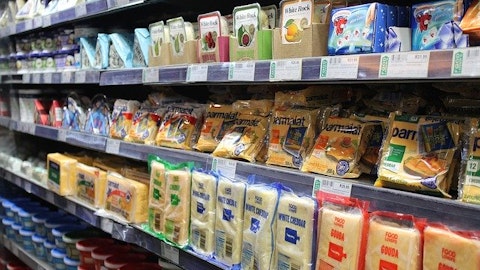United Natural Foods, Inc. (NYSE:UNFI) Q1 2023 Earnings Call Transcript December 7, 2022
United Natural Foods, Inc. misses on earnings expectations. Reported EPS is $1.13 EPS, expectations were $1.15.
Operator: Good morning, my name is Devin and I will be your conference operator for today. At this time, I would like to welcome everyone to the UNFI First Quarter Fiscal 2023 Earnings Call. All lines have been placed on mute to prevent any background noise. After the speakers’ remarks, there will be a question-and-answer session. Thank you. Vice President of Investor Relations, Steve Bloomquist, you may begin your conference.
Steve Bloomquist: Good morning everyone and thank you for joining us on UNFI’s first quarter fiscal 2023 earnings conference call. By now you should have received a copy of the earnings release issued this morning. The press release and earning presentation, which management will speak to are available under the Investors section of the company’s website at www.unfi.com. We’ve also included a supplemental disclosure file in Microsoft Excel with key financial information. Joining me for today’s call are Sandy Douglas, our Chief Executive Officer and John Howard, our Chief Financial Officer. Sandy and John will provide a strategy and business update after which we’ll take your questions. Before we begin, I’d like to remind everyone that comments made by management during today’s call may contain forward-looking statements.
These forward-looking statements include plans, expectations, estimates, and projections that might involve significant risks and uncertainties. These risks are discussed in the company’s earnings release and SEC filings. Actual results may differ materially from the results discussed in these forward-looking statements. And lastly, I’d like to point out that during today’s call management will refer to certain non-GAAP financial measures. Definitions and reconciliations to the most comparable GAAP financial measures are included in our press release and the end of our earnings presentation. I’d ask you to turn to slide six of our presentation as I turn the call over to Sandy.

Photo by Louis Hansel on Unsplash
Sandy Douglas: Thank you, Steve and good morning everyone. We appreciate you joining us for our first call of our new fiscal year. Our focus continues to be executing our Fuel the Future strategy, underpinned by our priority of bringing more value to our customers, improving the way we partner with suppliers, creating unmatched career opportunities for our associates, and supporting our communities in the planet. As you will have seen in our release, we started the fiscal year with a nearly 8% increase in sales, as more customers are buying more categories from UNFI than ever before. The competitive advantages I laid out in September, namely our scale, vast distribution network, data and analytics capabilities, diversity of customers and suppliers, and growing management talent have led to a strengthening customer pipeline.
We are investing in an elevated level across the company to better serve our customers, including training and upskilling for our customer support and sales teams and we’re beginning to see early results. We continue to gain share of our addressable wholesale market and we’re confident that we’ll be adding more new customers and new categories and services with current customers during the back half of this fiscal year. Our sales growth this quarter also reflects a complex operating environment characterized by persistently high levels of food inflation and elasticity as consumers increasingly look for ways to stretch their household budgets, translating into unit weakness across much of the industry. Changes to the grocery landscape will inevitably continue shaped by both macroeconomic factors such as inflation and supply chain, as well as changing and evolving consumer preferences.
For the past two years, UNFI’s customers have had to reassess and adapt nearly every facet of their operations and we’ve done that right alongside them. Our customers face growing competition and changing consumer preferences based on the pressures that consumers are experiencing. None of these are unique to our customers, but we’re ensuring that our customers can increasingly count on us to be their partner of choice as they focus on the trends that really matter. In this changing environment, we believe UNFI is well-positioned for further value creation, leveraging our scale, diversification, private brands, and professional services portfolio that helps our customers drive, sales and save money are all drivers of differentiated capabilities that enhance connectivity and market visibility for both our customers and suppliers.
Among trends, we know many consumers are seeking value, which doesn’t always mean merely the lowest price or cheapest option. Our merchandising programs help deliver this value across the store in ways such as new digital shelf tags and digital coupons, strategic buying events and shows, as well as our private brand program. Through partnering closely with stakeholders across the value chain, UNFI is helping drive more favorable pricing for our customers and increased volumes for suppliers into and with our nationwide footprint of 30,000 plus customer locations. We strive to be their partner of choice, known for our commitment to leverage our scale and expertise to help them succeed and compete. All of this translates into increased sales and a healthy customer pipeline.
Higher sales drove a strong increase in gross profit dollars this quarter, which combined with diligent management of our operating expenses contributed to a 3.5% year-over-year increase in adjusted EBITDA. One overarching theme you’ve heard me speak about before is our commitment to improving capabilities from serving customers to partnering with suppliers. This includes enhancing operational performance and improving reliability and speed for our customers. We have several strategic initiatives underway aimed at enhancing customer and shareholder value by doing just that. And during the quarter, we were pleased to see examples of strong progress across the company, including improving fill rates, outbound quality, and expense rates. We’re managing our SG&A spending well and have shifted existing dollars into higher strategic priorities aimed at driving growth and profitability, including growth opportunities in our services platform and added resources in digital and business transformation to improve the way we serve customers.
This quarter, we strengthened our center-led regionally focused merchandising teams, who will be helping develop local programs and solutions that leverage our national scale. Within operations, our facilities are staffed better than at any point since the start of fiscal 2022 and our capabilities are improving as newer associates gain experience and increase their productivity levels. Efficiency and fill rates are increasing and we believe these trends will generate higher service and operating efficiency levels and customer satisfaction, while continuing to favorably impact our operating expense rate in the remainder of the year. I’m especially encouraged by and grateful for the many unsolicited comments that we’ve received from our customers commending us on the improvement and how we’re servicing their stores.
We have much more work to do, but it’s encouraging to see the investment and continuous improvement beginning to pay off. Going forward, we expect technology and automation investments that we introduced on our last call to be a meaningful growth and profitability enabler in the years ahead. These investments are expected to help us efficiently manage the anticipated higher volumes that we plan to capture as we gain an increasingly larger portion of the approximate $140 billion addressable market that we’ve outlined previously. Let me come back to two areas in which we believe that UNFI has a real and growing competitive advantage, namely private brands and professional services, where each continues to do well on both the top and the bottom-line.
As I touched upon a moment ago, private brands is one way that consumers are finding value in the store and in Q1, our private brand sales growth outpaced total industry private brands growth. Our growth aspirations we discussed at our last Investor Day for our brands remains unchanged. We’ve recently brought additional brand and commercial experience to the brand’s leadership team and we’re optimistic that the value proposition we bring to our customers will significantly improve as we go forward. At the same time, we once again achieve double-digit adjusted EBITDA growth in our professional services business by meeting the ever-evolving needs of our customers for tailored solutions that help them grow faster and run their businesses more efficiently.
We remain focused on growing gross profit dollars and further improving our supply chain execution, which will enable us to overtime grow adjusted EBITDA and capital returns faster than sales. As the external environment continues to change, we’re keenly focused on getting better at what we do. So, we’re better able to service our customers and help them meet their business goals. We have a high degree of confidence in our ability to capitalize on the growth opportunities we see with both existing and new customers by continuing to execute our Fuel the Future strategy. We have a large, diverse, and vibrant customer base that continues to see us demonstrate each and every day, our commitment to helping them succeed and we believe our focus on continuous improvement will lead to growth and perpetuate the flywheel effect that I’ve described in the past.
Finally, we continue to be focused on our planet and the communities we serve. This quarter, we partnered with a climate collaborative to launch a series of educational sessions informed by our recent published climate action guide for businesses, exploring the steps that we can take together with our value chain community to address climate change and achieve our science-based targets by 2030. To further support these goals, we are nearing completion of our largest rooftop solar array to-date at our Howell, New Jersey distribution center, which is expected to go live by the end of this year. We also announced a partnership with Square Roots that will allow us to co-locate indoor farms at select distribution centers across our network with the first plan for Prescott, Wisconsin in 2023.
These indoor farms are an example of an innovative solution designed to strengthen our supply chain and give back days of freshness to consumers while reducing waste, lowering greenhouse gas emissions, and advancing sustainable growing practices. We plan to release our next ESG report early next calendar year and we’ll provide some highlights on our next call. We view this work as integral to our operations and our growth agenda. Growing and getting better at what we do is what excites and motivates our entire leadership team and I’m pleased with the progress we’re making. Importantly, our solid start to the year keeps us on track to deliver our full year guidance provided in September. As we look to the future, UNFI is on a path to creating significant shareholder value by continuing to win more customers and new business across all aspects of our addressable market.
Adding more customers in more categories also creates more value for our suppliers, which helps them invest more significantly over time in our customers. At the same time, we are operating our business in an increasingly more efficient manner, from our distribution centers and services platform to our retail stores to our corporate offices. Taken together, we are confident this virtuous cycle will lead to greater profitability stronger, cash flows, and outsized returns on invested capital for our shareholders. With that, I’ll turn the call over to John for detail on our financial results, capital structure, and outlook. John?
See also 10 Most Undervalued Stocks To Buy and Stocks On the Rise: 12 Best Stocks To Buy.
John Howard: Thank you, Sandy and good morning, everyone. As you heard from Sandy in the first quarter, we delivered increased sales, gross profit dollars, and adjusted EBITDA, all of which keeps us on pace to meet the full year outlook we provided in September. Turning to slide eight, let’s start with net sales, which grew by nearly 8% in the first quarter and totaled $7.5 billion, setting a new first quarter record. Wholesale growth included inflation, net of elasticity as well as new customers, and new categories with existing customers, partially offset by a decline in unit volumes. In wholesale, we delivered widespread sales growth across all three primary channels, which grew by close to 8% on a combined basis. This includes incremental volume from new customers added over the last year, additional categories and new store openings in supernatural, and increased item and category penetration with existing customers.
As Sandy mentioned, we expect contributions from new customers and existing customer expansion to increase in the back half of the year. Sales in our retail business increased by about 2%, which was driven by higher average unit retail pricing. Our Cub banner, which remains the market leader in the Twin Cities continues to generate strong sales in its pharmacy, which shows the trust and confidence shoppers place in the brand. We’re also continuing to grow our e-commerce business at Cub as we look to migrate consumers to a new and enhanced platform. Flipping to slide nine, adjusted EBITDA totaled $207 million up 3.5% over last year’s first quarter. Our gross profit dollars prior to the LIFO charge in both years increased by $64 million over last year’s first quarter and gross profit rate declined to 20 basis points, driven by changes in both wholesale customer and product mix.
Within our retail segment, gross margin rate for Q1 was flat compared to last year. Our operating cost as a percentage of sales improved sequentially from the fourth quarter and were flat compared with the first quarter of last year. We continue to invest in distribution center and transportation labor to provide the highest possible service levels for our customers, and we also experienced inflationary pressures on certain fixed occupancy-related expenses such as utility and energy costs. As a result of the People First initiatives we’ve previously spoken about, we continue to drive improved vacancy rates. As our more recent hires continue to ramp up to the productivity standards of more experienced associates, we expect to continue to see a favorable impact on our service and operating efficiency in the back half of the year.
Within our retail segment, adjusted EBITDA was down about $2 million compared to last year’s first quarter. This decline was largely the result of an incremental health and welfare payment and start-up costs associated with three new shopper stores we reacquired and subsequently reopened. Overall, the team did a good job balancing sales and promotional spending and continues to work on various cost-saving initiatives that we believe will contribute positively to the remainder of the year. Our GAAP EPS was $1.07 in the quarter, which included a $0.34 pretax LIFO charge as well as several smaller pretax items. Adjusting for these items and removing a favorable GAAP tax benefit related to the vesting of employee stock awards, our adjusted EPS totaled $1.13, up 2.7% from last year’s $1.10.
This increase included a $0.04 or roughly 3.5% headwind from lower non-cash pension income that we discussed on our last call, as we look to de-risk our pension plans. Moving to slide 10, we finished the quarter with total outstanding net debt of $2.49 billion, a $378 million increase compared to year-end. This reflects an investment in working capital as we add inventory going into the holiday selling season in support of our customers as well as the impact of inflation. This expected seasonal increase in working capital should largely convert to cash in the second quarter. Given the higher debt level, our net debt to adjusted EBITDA leverage ratio increased compared to year-end to 3.0 times. On a year-over-year basis compared to last year’s Q1, this leverage ratio declined by about 0.1 turn.
Shortly after the quarter ended, we paid down approximately $253 million of net debt with the proceeds from the AR monetization program I discussed on our last call, which would equate to about 0.3 times on our adjusted EBITDA to net debt leverage ratio. This had the corresponding effect of removing approximately $250 million in qualified accounts receivable from our balance sheet. These changes will be reflected in our Q2 balance sheet and will contribute to lowering our leverage ratio and overall cost of funding our business. We still expect our year end adjusted EBITDA leverage ratio to be lower than last year’s 2.6 times, driven by net debt reduction over the coming three quarters, including the benefits from the AR monetization program and higher full year adjusted EBITDA.
We’re currently expecting to finish fiscal 2023 near the midpoint of the 2.0 to 2.5 times target we previously provided. During the quarter, we also made initial purchases of UNFI stock under our new stock repurchase program, buying 339,000 shares at an average price of $35.85 for a total cost of approximately $12.2 million, including fees and commissions. As we continuously work to create value for shareholders, we will look to opportunistically repurchase shares under our $200 million authorization. Turning to slide 11, as stated in our press release, we are affirming our full year outlook for fiscal 2023, this includes our expectations for net sales of $29.8 billion to $30.4 billion, adjusted EBITDA of $850 million to$880 million, and adjusted EPS of $4.85 to $5.15 per share.
Our outlook for fiscal 2023 capital spending remains at $350 million, with a portion of the total spend going towards automation. We’re finalizing the initial set of DCs based on existing volumes, our expectations toward future growth across our markets, and the efficiency benefits that we expect will deliver strong financial returns above our cost of capital. The forecasted after-tax IRR from the first automation installation is over two times our estimated cost of capital. In summary, as outlined on slide 12, we’re pleased to reaffirm our full year guidance, which still allows us to make necessary investments to service our customers, which remains our priority. Our pipeline remains robust and we expect existing and new customer opportunities to benefit the second half of the fiscal year.
We’re encouraged with the improvements that we see within our operations as evidenced by the trends in staffing, bill rates, and operating efficiency. We plan to continue deleveraging our balance sheet and to finish fiscal 2023 with total net debt below fiscal 2022’s ending balance driven by cash generated from operations as well as the benefits of AR monetization. Our confidence in the business and belief in our ability to increase shareholder value has led us to begin repurchasing shares, which we plan to continue to opportunistically pursue. It continues to be an exciting time at UNFI. We remain confident that our strategy is working with tremendous improvement opportunities ahead of us, and we look forward to updating you on our progress in March.
Operator, please open the line for questions.
Q&A Session
Follow United Natural Foods Inc (NYSE:UNFI)
Follow United Natural Foods Inc (NYSE:UNFI)
Receive real-time insider trading and news alerts
Operator: Our first question comes from John Heinbockel with Guggenheim.
John Heinbockel: So, Sandy, let me start maybe 2 longer-term questions. One, the changes to the merchandising organization. Maybe talk to the key structural changes and what you think the benefits of that will be? And then secondly, when you think about the pace at which you can get automation rolled out, what’s your thought process on that today versus maybe three months ago?
Sandy Douglas: Thanks John. Good morning. The merchandising changes we made, we took our two strongest leaders who deal with suppliers end-to-end from procurement all the way down through working with customers in markets around the country. and we link them together with all of our regional merchandising organizations. And the idea is that our customers obviously operate locally. There are local opportunities that we are working with them on, on a regular basis. And what we’ve been working on is improving the link and visibility between local opportunity and the suppliers themselves, so that we can facilitate their ability to see the opportunity and facilitate their ability to invest in it and get a return, which creates a positive cycle in terms of growth.
And the leaders are very experienced. They were in place, but we just made the organization much more seamless, so the process works better. Regarding automation, while our implementation schedule on automation is obviously competitively sensitive. The way I would think about that is that we will begin the implementation in fiscal 2023, we’re going to learn a lot about that based on kind of working through the process. And then we will implement as quickly as we can over the next few years assuming that we can continue to validate the strong returns that John talked about and the customer benefits that were designed to deliver through the automation initiative.
John Heinbockel: Great. And then maybe my follow-up, if I think about your commentary on pipeline, right? Maybe speak to your visibility now because it sounds like there’s a good deal of visibility in the second half. Your visibility maybe versus a quarter or two ago? And then where is the visibility greatest right? What do you think the impact, is it going to be new customers? I know nothing is like , but new customers or new categories with existing customers? Where is the visibility greatest?
Sandy Douglas: Sure. And John we’ve been commenting in the five calls that I’ve been a part of about the strength of the pipeline. But obviously, one of the benefits of a pipeline is converting that to new customers or new categories. And as we did comment in the call, we have some visibility to that in the second half. I would always want to say when talking about new opportunities, though, that the most important thing we focus on every day is our existing customers, making sure that we’re serving them well, we’re merchandising with them well, and we’re helping them compete and succeed in this environment. And probably the most positive thing about our pipeline is the majority of the opportunities are expansion with existing customers, which is good for a couple of reasons.
First, it leverages our infrastructure that we’re using to serve the customers. And secondly, because it reflects the healthy relationship that we’re building. And so I would say if you were to look at where the biggest opportunities that we see are and where our near-term visibility is, it would be more of that kind of expansion with existing customers rather than new ones, although there are some new ones as well.
John Heinbockel: Thank you.
Operator: Our next question comes from Leah Jordan with Goldman Sachs.
Leah Jordan: Hi, good morning. Thank you for taking my question. First, I wanted to start off on gross margins. I saw they were down a little bit in the quarter. You called out the mix shift to larger customers. Should we think about that pressure kind of persisting throughout the year? Or is there anything specific about this quarter that we should keep in mind?
Sandy Douglas: Thanks Leah for the question. I mean, effectively, we’re focused on driving healthy growth in gross profit dollars. And the reason for that is that we look at every single one of our customer agreements with disciplined eye for economic returns. A lot of our growth in the first quarter came with some of our bigger customers. But over time, I think you saw that all of our channels grew. And so there’ll be some fluctuation, but I would describe what you saw in the first quarter is minor and just more a function of the temporary growth drivers in our customer file.
Leah Jordan: Okay, great. Thank you. And then my follow-up is kind of around the topline, building a little bit off of that pipeline discussion. You guys have been pointing to kind of 4% topline growth for the year, a little elevated this first quarter, how are you thinking of the balance of food inflation and the outlook of that through the year with volumes as well as the new opportunities in the back half?
Sandy Douglas: Sure. Well, like all people in my line of work, we’re interested in what the future holds in inflation, but we’re not economic experts. So, — and I didn’t just become one over the last month or two. I think from a growth perspective, we do expect that inflation will level off and moderate some in the go-forward periods. But our focus is on driving the things that we can control, which is taking care of existing customers, merchandising well, and then activating our pipeline for growth and from our perspective, our growth prospects against the $140 billion addressable market that we’ve identified is very strong. The mix of inflation and elasticity and units — I mean, our unit performance in the quarter was down 3%.
We saw about10% inflation, down 3% was in line with the total industry, including some of the large box retailers that have been driving growth because of value in the more recent past, and we’re continuing to work really hard to make sure that our customers are as competitive as they possibly can be. And by virtue of that, that of course, drives our ability to earn more business with them as we go forward. So, those are the pieces, the way they add up is in line with our guidance that we reformed this morning.
Leah Jordan: Great. thank you.
Operator: Our next question comes from Andrew Wolf with CL King.





